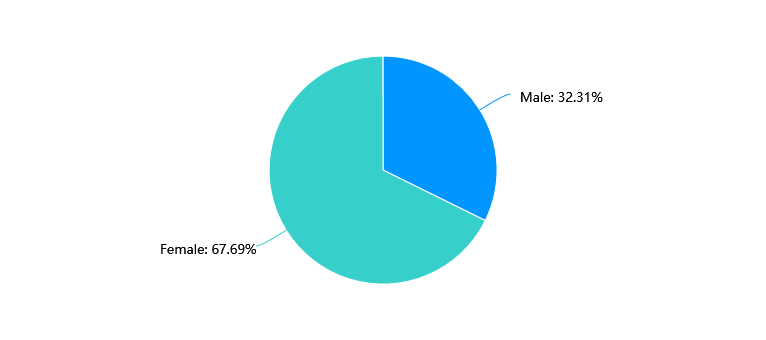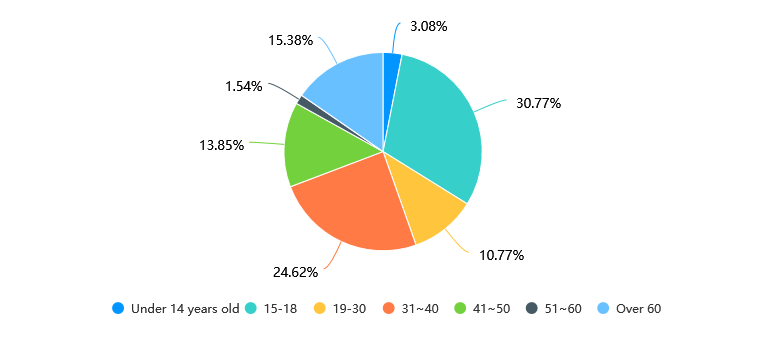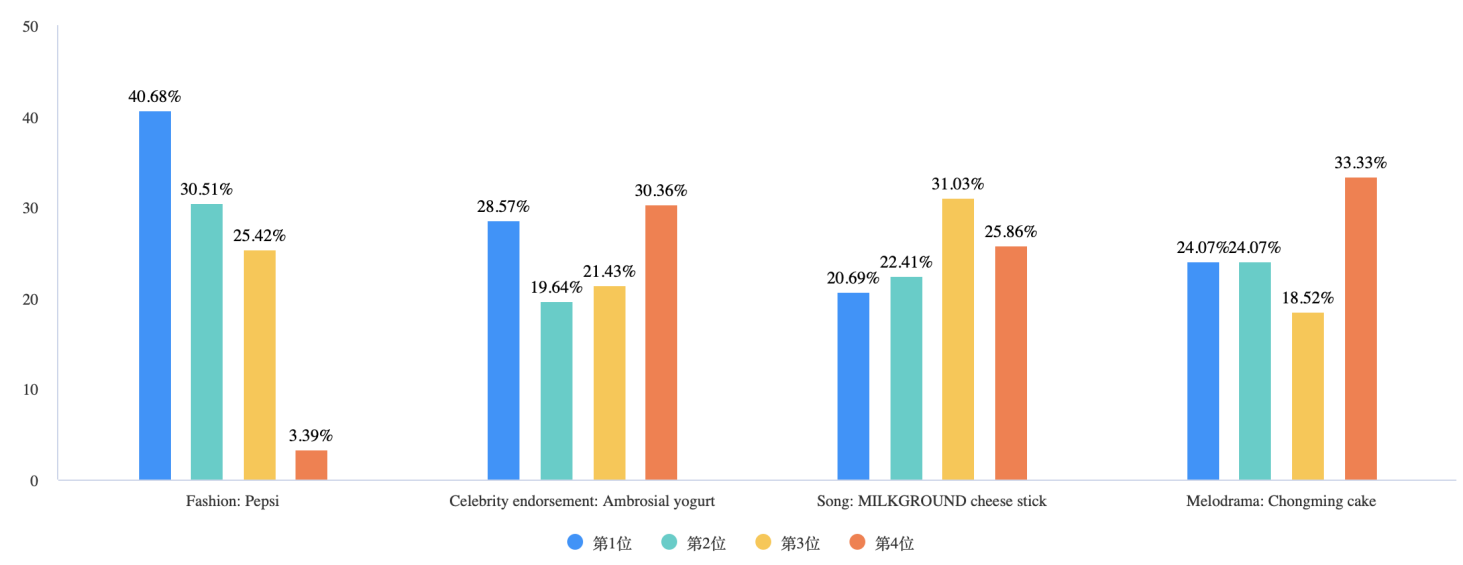1. Introduction
Any business strategy should include advertising since it is a key factor in influencing consumer behavior. The choice of advertising media can affect the effectiveness of an advertising campaign and how it resonates with consumers. The authors' surprising discovery that price promotions are the least significant value driver [1]. Instead, the content and form of the advertisement are the decisive factors. Therefore, understanding the influence of different advertising media on consumer’s choice is crucial for marketers who want to maximize their reach to their target audience. Additionally, social media advertising has grown to play a significant role in modern marketing. All ages' most popular communication platforms have been found to be social media [2]. Therefore, it is very necessary to explore the impact of different advertisements in social media on consumer attraction. Technologies based on images have a tremendous potential to present consumers with products by emphasizing their visual qualities because vision is so crucial [3].
Previous research has shown that different advertising media have different effects on consumers. For instance, the Internet had the greatest impact on consumers' plans to make purchases. The second-highest influencer was the new media. New media advertisements can have a favorable impact on customers [4].
With the growth of social media platforms and online advertising in recent years, digital advertising has also increased in popularity. Online advertisements (Ads) can demonstrate tremendous marketing skill by processing data from many channels to deliver information, recognizing what people want, and reaching them simply, according to research. Digital advertising offers several advantages over traditional advertising media [5]. This is why the author chose digital video ads for research.
Previous research has also shown, consumers' money and education had just a small impact on the association between their purchasing decisions and social media advertising, whereas their gender, age, and culture all have significant moderating effects [6]. Therefore, this study can also focus more on exploring the specific impact of age and gender on consumers. At the same time, A fully mediated effect of emotional brand attachment on social media brand equity is supported by consumers' attachment to brands [7]. There is a need to ensure that consumers are not exposed to provocative advertising, given that the participants who felt cognitive dissonance had a bad opinion of the commercials, the brand, and bad purchasing intentions [8]. Additionally, since the widespread use of the Internet and social media has altered how customers communicate with one another and how businesses interact with their clients, it is important for them to pay attention to how consumers talk about products because this influences the reputation of those products [9].
Given the wide range of advertising media available, it is important to understand the relative advantages and disadvantages of each and how to use them effectively to reach and engage consumers. The purpose of this paper is to explore the impact of different advertising media on consumers, and to investigate the types of songs, fashion, celebrity endorsement and sitcom advertisements, with special emphasis on the factors that affect their effectiveness. By analyzing case studies, the authors hope to provide insights into how businesses can optimize their advertising strategies to achieve the best results.
2. Method
In this study, a questionnaire survey was adopted to understand the preferences of people of all ages for different forms of advertising, and to explore the impact of advertising media on the consumer market. Effective data were obtained by providing four representative advertisement samples in the questionnaire and asking respondents to rank them and explain their reasons. First, the questionnaire design ensures the basic attribute information of data collection by asking respondents to fill in their gender and age. Then, in order to fully consider the characteristics of different types of advertisements, the author carefully selected representative advertisement links from four different perspectives, namely, fashion, star endorsement, song and situational drama, as samples, respectively: Pepsi ads for fashion, Ambrosial yogurt ads for celebrity endorsement, MILKGROUND cheese stick ads for song, and Chongming cake ads for melodrama. The sample of these advertisements can reflect the various ways in which advertisements are presented, so as to better understand the preferences and reactions of consumers to advertisements. After watching the four advertisements, interviewees can rank them from the most attractive to the least attractive according to their preferences. At last, interviewees should give corresponding reasons for their ranking results. After collecting these data, the author can analyze the gender, age, ranking method and ranking reasons, explore the respondents' preference for different types of advertisements, and explore the causal relationship between age and gender for this result. Questionnaires are completed by the issuer using questionnaire Star and distributed online by generating QR codes and links for 6 days from May 11 to May 16. Finally, in the process of issuing and recovering questionnaires, the author adopted a variety of ways to effectively distribute them. Such as moments, wechat groups, private messages and other social media channels. After the questionnaires were collected, the author checked the data through manual review and selected 65 valid questionnaires to ensure the authenticity and availability of the data. Through the analysis of the above data, the author can explore the preferences of respondents of all ages for different types of advertisements, and further study the influence of age, gender and other factors on the consumer market. These research results have a positive guiding significance for the decision makers and marketers in the advertising industry, and can provide them with more accurate market positioning and advertising programs.
3. Result
3.1. Respondent Data
This poll on advertising types gathered a total of 65 valid questions. Among the respondents, as Figure 1 shows, men accounted for 32.31 percent, or 21, while women accounted for 67.69 percent, or 44. The number of female respondents is significantly higher than that of male respondents, which means that this survey more reflects women's needs and wishes for advertising types.

Figure 1: Gender ratio (Photo/Picture credit: Original).
Also, in terms of age, as Figure 2 shows, the author divided the options into seven distinct groups: under 14 years old, 15-18, 19-30, 31-40, 41-50, 51-60, and over 60. According to the data, 3.08% (2 people) are under the age of 14, 30.77% (20 people) are between 15 and 18, 10.77% (7 people) are between 19 and 30, and 24.62% (16 people) are between 31 and 40. 13.85% (9 people) were aged 41-50, 1.54% (1 person) were aged 51-60, and 15.38% (10 people) were over 60. There are also differences in the type of advertising needed by different age groups, such as those aged 15 to 18 and those aged 31 to 40.

Figure 2: Age ratio (Photo/Picture credit: Original).
3.2. Survey Result
Then, the respondents ranked the four food advertisements from the most attractive to the least attractive. According to the statistics, as Figure 3 shows, the overall score of the fashion type Pepsi advertisement was 2.8, ranking the first. The MILKGROUND cheese stick advertisement of songs and Ambrosial yogurt advertisement of celebrity endorsement both got 2.12 points and ranked the second place. the Chongming cake for the melodrama ranked the third with a combined score of 1.98.

Figure 3: Advertising attraction ratio (Photo/Picture credit: Original).
3.2.1. Fashion Type of Pepsi Advertisements
Detailed data point out that, first of all, for the fashion type of Pepsi advertisements, the number of people who put it in the first place is the most, 24 people, accounting for 40.68%; The second place is also the largest, with 18 people, accounting for 30.51%; It was ranked third by 15 people, accounting for 25.42%; Only 2 people, or 3.39 percent, ranked it last. These figures show that most people prefer fashion types of ads and want them placed in the most visible spots. At the same time, the author found that the reason why most of the respondents chose fashion advertisements as the top one was that they thought fashion advertisements had a strong sense of art, and their comfort and enjoyment of watching videos were high. Most of the respondents wrote in their reasons of choice that Pepsi advertisements of fashion type made Pepsi Cola "look delicious". This largely caught their attention.
3.2.2. Song Type of MILKGROUND Cheese Stick Advertisements
For MILKGROUND cheese stick advertisements of song type, 12 people ranked it first, accounting for 20.69%; 13 people, or 22.41 percent, ranked it second. 18 people ranked it third, accounting for 31.03 percent; Fifteen people ranked it fourth, accounting for 25.86%. From these data, most people put song type ads in the middle and at the bottom of the test. By investigating the reasons for the choice of interviewees, the author found that those who ranked the top of the list for the type of song advertisement generally thought that the melody of the song was simple, easy to remember and impressive, and the picture content was also simple. Most interviewees said that the type of song advertisement could make people associate the song with the commodity, and they would think of the commodity when they heard the song. When people see merchandise, they think of songs. For those who ranked song ads lower, they generally found the songs annoying and repetitive. Therefore, the author can draw a conclusion that the melody of a song largely determines the degree of people's liking for the advertisement of the song type. Although simple melody can make the public remember quickly and associate the advertisement with the commodity, it will also make people feel upset.
3.2.3. Celebrity Endorsement Type of Ambrosial Yogurt Advertisement
For Ambrosial yogurt advertisement with celebrity endorsement, 16 people ranked it first, accounting for 28.57%. 11 people ranked it second, accounting for 19.64%; 12 people ranked it third, accounting for 21.43%; It was ranked fourth by 17 people, or 30.36 percent. The data revealed a wide range of preferences for celebrity advertising, with almost equal numbers ranking it 'most attractive' and 'least attractive', while relatively few ranked it in the middle. Through the investigation, the author found that the respondents who think the advertisement endorsed by stars is more attractive are mostly star-admirers. They mentioned that the reason why they like the advertisement is because they like the star, and they think the advertisement endorsed by the star should be more formal goods. However, the respondents who think the advertisements endorsed by stars are not attractive are mostly those who do not follow stars and think that such advertisements do not reflect the advantages of the products.
3.2.4. Melodrama Type of Chongming Cake
For Chongming cake, 13 people ranked it first, accounting for 24.07 percent. It was ranked second by 13 people, also 24.07 percent; 10 people ranked it third, accounting for 18.52%; 18 people, or 33.33 percent, ranked it fourth. These data show that one third of the interviewees think that the advertisements of melodrama are the least attractive. The reasons they give are that they think the plots of melodrama are boring, not innovative, and the time is too long, which wastes the viewers' time. Moreover, they are complicated and make people not want to watch them. However, the respondents who ranked the top of the list of melodrama types said that the advertisements of melodrama types have a strong sense of engagement and can help them learn some knowledge. They said that they like the advertisements with connotation and stories.
4. Discussion
According to the results of the survey, the following conclusions can be drawn. First, because there were more women and fewer men in the survey. The study demonstrates that various advertising appeals may have a distinct effect on a consumer's purchase intention; for women, the emotional appeal has a bigger effect than for males, who are more likely to be influenced by the rational appeal [10]. Therefore, the results of this study will be more inclined to emotional appeals. In the survey, teenagers are more likely to prefer advertisements featuring celebrity endorsement. This is also because many people between the ages of 15 and 18 put celebrity endorsements first and second. The reason they give is star-chasing. Most teenagers will be influenced by their favorite stars to buy a certain product. In addition, most teenagers think the advertisements of sitcom type are boring and not very popular with them. Respondents aged between 19 and 30 were more likely to prefer fashion ads. the author thinks the reason is that respondents in this age group prefer something fashionable and beautifully made. They are more interested in and attracted by the fashion information conveyed by the advertisement, which prompts them to pay attention to the brand and goods. Meanwhile, the survey also showed that respondents aged 31 to 40 prefer fashion and song ads. This may be because the images and melodies presented by these ads are so impressive. Such advertisements are easy to leave memories in the minds of consumers, making it easier for consumers to recall the brand and products. Respondents aged 41 to 60 and over say they prefer fashion and sitcom-style ads compared to younger people. It makes them feel warm and comfortable, and they also mention that sitcom ads are a good way to show the practicality of the product. People in these age groups pay more attention to the emotional value conveyed by the advertisement and the practicality of the product itself, and pay more attention to the practical value and quality of the commodity, so they ignore the artistry and creativity of the advertisement to some extent. After all, for this age group, purchases are more about meeting actual needs than following trends. To sum up, according to the survey results of respondents in different age groups, the following suggestions can be drawn: For teenagers, they can consider choosing advertisements with celebrity endorsement, and pay attention to not being boring in advertising production. For respondents aged between 19 and 30, they should choose some fashionable, exquisite and easy to remember advertisement types. For respondents aged 31-40, consider adding song elements to enhance the appeal of the advertisement. For respondents aged 41 to 60 and over 60 years old, some episodic advertisements can be selected to emphasize the practical value and quality of the goods.
The author will give different recommendations for each type of advertising. First of all, fashion advertisements, which are highly attractive and influential in marketing, are favored by most interviewees. As a result, advertisers can choose to produce more fashion type ads to sell goods. At the same time, since fashion is an ever-changing trend, advertisers can follow the latest fashion trend and make more fashion-forward advertisements to attract the young consumer group. Secondly, song type advertising is also a very popular form of advertising. The author suggests that advertisers can choose to create some beautiful melody, simple music to produce song type advertising. Such advertisements can leave a deep impression and are easy to be accepted and spread by people. Of course, advertisers can also choose some popular songs as background music to increase the popularity of advertisements. The third type is the star endorsement type of advertising. In this kind of advertising, the image and personal charm of the stars can often attract the attention of consumers. Therefore, advertisers can choose to invite some stars consistent with the product content to perform, for example, cosmetics advertisements can choose beautiful young female stars, while sports clothes advertisements can choose strong male stars to represent. However, the author should also remind advertisers to pay attention to the negative news and influence of stars to avoid the negative impact on the brand. Finally, there are many factors that need to be paid attention to in the advertisements of melodrama type. The author suggests reducing the content of the plot, shorten the duration of the advertisement, and pay attention to the beauty of the scene. Such advertisements can highlight the characteristics and selling points of products, and also make the audience pay more attention to the content of the advertisement itself, so as to achieve the effect of brand promotion.
5. Conclusion
In conclusion, this study uses questionnaires to look into the effects of advertising media on the consumer market as well as the preferences of various age groups for different types of advertising. The results showed that fashion ads were the most attractive across all age groups, followed by songs and celebrity endorsement ads, while melodrama ads were the least popular. The study also revealed differences in advertising preferences among different age groups, with teens preferring celebrity endorsements, while respondents aged 41 and over preferred fashion and sitcom-style ads. Based on these findings, the author offers some suggestions for advertisers to create more effective advertising campaigns. Overall, the findings provide valuable insights for decision makers and marketers in the advertising industry to develop more accurate market targeting and advertising programs. However, in terms of research limitations, the questionnaire issued by this study was filled out by more women and fewer men. Therefore, more studies on men's preferences for different advertising media should be conducted in the future.
References
[1]. Bues, M., Steiner, M. C., Stafflage, M., & Krafft, M. (2017). How Mobile In-Store Advertising Influences Purchase Intention: Value Drivers and Mediating Effects from a Consumer Perspective. Psychology & Marketing, 34(2), 157-174.
[2]. K. V. Sriram, K. P. Namitha, Giridhar B. Kamath (2021). Design Features That Influence Consumers’ Attention for Advertising In Social Media.
[3]. Cuenca-Bescos, G., Garcia-Garcia, C., Felip, F., & Contero, M. (2021). Does a presentation Media Influence the Evaluation of Consumer Products? A Comparative Study to Evaluate Virtual Reality, Virtual Reality with Passive Haptics and a Real Setting. International Journal of Interactive Multimedia and Artificial Intelligence, six (6), 196.
[4]. Ahn, J., Lee, C., Lee, J., & Paik, M. (2012). An analysis of different types of advertising media and their influence on consumer preferences and purchase intentions for digital cameras. Journal of Global Scholars of Marketing Science.
[5]. Kim, K., Kwon, E. Y., & Park, J. (2021). Deep User Segment Interest Network Modeling for Click-Through Rate Prediction of Online Advertising. IEEE Access, 9, 9812-9821.
[6]. Akayleh, F. A. (2021). The influence of social media advertising on consumer behaviour. Middle East Journal of Management, 8(4), 344.
[7]. Dwivedi, A., Johnson, L. W., Wilkie, D. C. H., & De Araujo-Gil, L. (2019). Consumer emotional brand attachment with social media brands and social media brand equity. European Journal of the Marketing, 53 (6), 1176-1204.
[8]. Robbins, A. (2011). Advertising in the fashion industry: The effects of socially provocative advertising on attitude toward the advertisement, the brand and consumer purchase intentions.
[9]. Toker Yildiz, Kamer. (2014). Essays on social influence, network effects and use of social media in impacting consumer behavior.
[10]. ovanović, P., Vlastelica, T., & Kostić, S. (2016). Impact of Advertising Appeals on Purchase Intention. Management: Journal for Theory and Practice Management, 21(81), 35–45.
Cite this article
Yang,Y. (2023). The Influence of Different Media Modes of Advertising on the Attractiveness of Consumers. Advances in Economics, Management and Political Sciences,40,91-97.
Data availability
The datasets used and/or analyzed during the current study will be available from the authors upon reasonable request.
Disclaimer/Publisher's Note
The statements, opinions and data contained in all publications are solely those of the individual author(s) and contributor(s) and not of EWA Publishing and/or the editor(s). EWA Publishing and/or the editor(s) disclaim responsibility for any injury to people or property resulting from any ideas, methods, instructions or products referred to in the content.
About volume
Volume title: Proceedings of the 7th International Conference on Economic Management and Green Development
© 2024 by the author(s). Licensee EWA Publishing, Oxford, UK. This article is an open access article distributed under the terms and
conditions of the Creative Commons Attribution (CC BY) license. Authors who
publish this series agree to the following terms:
1. Authors retain copyright and grant the series right of first publication with the work simultaneously licensed under a Creative Commons
Attribution License that allows others to share the work with an acknowledgment of the work's authorship and initial publication in this
series.
2. Authors are able to enter into separate, additional contractual arrangements for the non-exclusive distribution of the series's published
version of the work (e.g., post it to an institutional repository or publish it in a book), with an acknowledgment of its initial
publication in this series.
3. Authors are permitted and encouraged to post their work online (e.g., in institutional repositories or on their website) prior to and
during the submission process, as it can lead to productive exchanges, as well as earlier and greater citation of published work (See
Open access policy for details).
References
[1]. Bues, M., Steiner, M. C., Stafflage, M., & Krafft, M. (2017). How Mobile In-Store Advertising Influences Purchase Intention: Value Drivers and Mediating Effects from a Consumer Perspective. Psychology & Marketing, 34(2), 157-174.
[2]. K. V. Sriram, K. P. Namitha, Giridhar B. Kamath (2021). Design Features That Influence Consumers’ Attention for Advertising In Social Media.
[3]. Cuenca-Bescos, G., Garcia-Garcia, C., Felip, F., & Contero, M. (2021). Does a presentation Media Influence the Evaluation of Consumer Products? A Comparative Study to Evaluate Virtual Reality, Virtual Reality with Passive Haptics and a Real Setting. International Journal of Interactive Multimedia and Artificial Intelligence, six (6), 196.
[4]. Ahn, J., Lee, C., Lee, J., & Paik, M. (2012). An analysis of different types of advertising media and their influence on consumer preferences and purchase intentions for digital cameras. Journal of Global Scholars of Marketing Science.
[5]. Kim, K., Kwon, E. Y., & Park, J. (2021). Deep User Segment Interest Network Modeling for Click-Through Rate Prediction of Online Advertising. IEEE Access, 9, 9812-9821.
[6]. Akayleh, F. A. (2021). The influence of social media advertising on consumer behaviour. Middle East Journal of Management, 8(4), 344.
[7]. Dwivedi, A., Johnson, L. W., Wilkie, D. C. H., & De Araujo-Gil, L. (2019). Consumer emotional brand attachment with social media brands and social media brand equity. European Journal of the Marketing, 53 (6), 1176-1204.
[8]. Robbins, A. (2011). Advertising in the fashion industry: The effects of socially provocative advertising on attitude toward the advertisement, the brand and consumer purchase intentions.
[9]. Toker Yildiz, Kamer. (2014). Essays on social influence, network effects and use of social media in impacting consumer behavior.
[10]. ovanović, P., Vlastelica, T., & Kostić, S. (2016). Impact of Advertising Appeals on Purchase Intention. Management: Journal for Theory and Practice Management, 21(81), 35–45.









